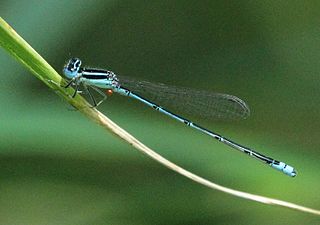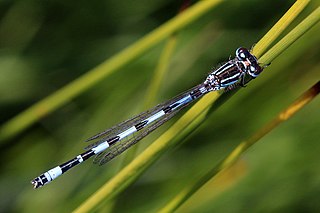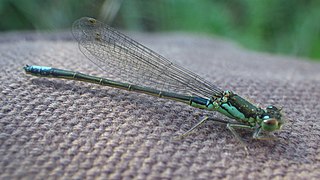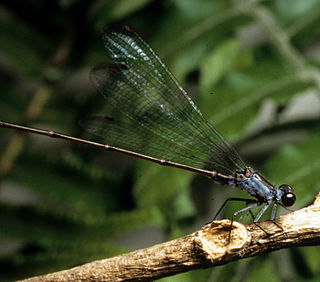
Damselflies are insects of the suborder Zygoptera in the order Odonata. They are similar to dragonflies, which constitute the other odonatan suborder, Anisoptera, but are smaller, have slimmer bodies, and most species fold the wings along the body when at rest, unlike dragonflies which hold the wings flat and away from the body. An ancient group, damselflies have existed since at least the Lower Permian, and are found on every continent except Antarctica.

Megalagrion is a genus of damselflies in the family Coenagrionidae It contains approximately 26 species, all of which are endemic to Hawaiʻi.

The insect family Coenagrionidae is placed in the order Odonata and the suborder Zygoptera. The Zygoptera are the damselflies, which although less known than the dragonflies, are no less common. More than 1,300 species are in this family, making it the largest damselfly family. The family Coenagrionidae has six subfamilies: Agriocnemidinae, Argiinae, Coenagrioninae, Ischnurinae, Leptobasinae, and Pseudagrioninae.

The Pseudostigmatidae are a family of tropical damselflies, known as helicopter damselflies, giant damselflies, or forest giants. The family includes the largest of all damselfly species. They specialize in preying on web-building spiders, and breed in phytotelmata, the small bodies of water held by plants such as bromeliads.

Azuragrion nigridorsum, the black-tailed bluet or sailing bluet, is a species of damselfly in family Coenagrionidae.

Coenagrion mercuriale, the southern damselfly, is a species of damselfly in the family Coenagrionidae. It is found in Algeria, Austria, Belgium, France, Germany, Italy, Liechtenstein, Luxembourg, Morocco, the Netherlands, Portugal, Slovakia, Slovenia, Spain, Switzerland, Tunisia, and the United Kingdom. Its natural habitats are rivers and freshwater springs. It is threatened by habitat loss.
Diceratobasis is a genus of damselfly in the family Coenagrionidae. The larva of species in this genus live in water that is trapped in bromeliads.
Diceratobasis melanogaster is a species of damselfly in the family Coenagrionidae. It is endemic to the Dominican Republic. Its natural habitat is subtropical or tropical moist lowland forests. It is threatened by habitat loss.
Enallagma recurvatum, the pine barrens bluet, is a species of damselfly in the family Coenagrionidae. It is endemic to the United States. Its natural habitat is freshwater lakes. It is threatened by habitat loss.

Hemiphlebia mirabilis, commonly known as the ancient greenling, is a species of damselfly in the family Hemiphlebiidae. It is very small with a long, metallic-green body and clear wings. It is endemic to south-eastern Australia. Its natural swamp habitat is threatened by habitat loss.

Ischnura gemina is a species of damselfly in the family Coenagrionidae known by the common name San Francisco forktail. It is endemic to the San Francisco Bay Area in California in the United States. This uncommon insect has a total range of less than 500 square miles in the Bay Area, occurring only in greater San Francisco and parts of San Mateo and Marin Counties. This species is "one of the rarest Odonates in the United States."

Megalagrion leptodemas is a species of damselfly in the family Coenagrionidae that is endemic to the island of Oʻahu in Hawaii. It inhabits rivers in the Waiʻanae and Koʻolau ranges. It is threatened by habitat loss. It is currently labeled as critically endangered.
Megalagrion molokaiense, common name Molokai damselfly, is a species of damselfly in the family Coenagrionidae. It is endemic to Hawaii. Its natural habitat is subtropical or tropical moist montane forests. It is thought that it breeds on dripping wet embankments or in small streams in habitats that lack gambusia.

Megalagrion nesiotes is a species of damselfly in the family Coenagrionidae. Its common name is flying earwig Hawaiian damselfly. It is endemic to Hawaiʻi, where it is known from only one location on the island of Maui. It is extirpated from the island of Hawaii. This insect was federally listed as an endangered species of the United States in 2010.

Megalagrion pacificum is a species of damselfly in the family Coenagrionidae. It is endemic to rivers and freshwater marshes in Hawaiʻi, especially the island of Molokaʻi. It is threatened by habitat loss. This insect was federally listed as an endangered species of the United States in 2010.
Mesagrion leucorrhinum is a species of damselfly. Its monotypic genus Mesagrion was formerly in the subfamily Argiolestinae of the flatwing damselfly family (Megapodagrionidae). As a result of molecular phylogenetic studies by Dijkstra et al. in 2013, the genus Mesagrion is considered "incertae sedis", without an assigned family but within the superfamily Calopterygoidea.
Pseudagrion assegaii is a species of damselfly in the family Coenagrionidae. It is found in Botswana, Namibia, South Africa, Uganda, Zambia, and Zimbabwe.
Titanosticta is a genus of damselflies in the family Isostictidae. There is one described species in Titanosticta, T. macrogaster.
Allocnemis abbotti, formerly Chlorocnemis abbotti, is a species of white-legged damselfly in the family Platycnemididae. It is found in Kenya, Malawi, and Tanzania. Its natural habitats are subtropical or tropical moist lowland forests, rivers, intermittent rivers, and freshwater springs. It is threatened by habitat loss.











